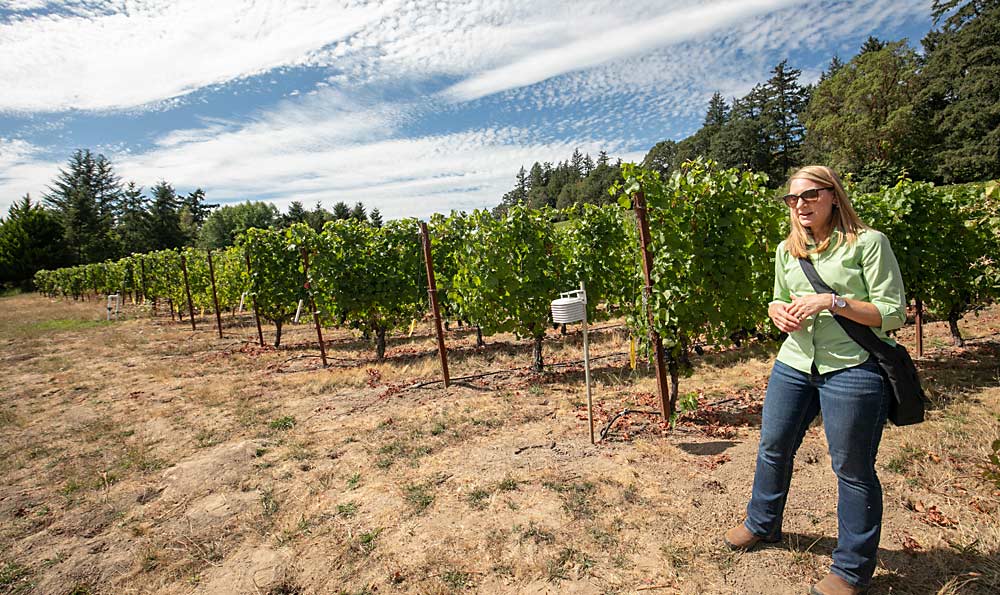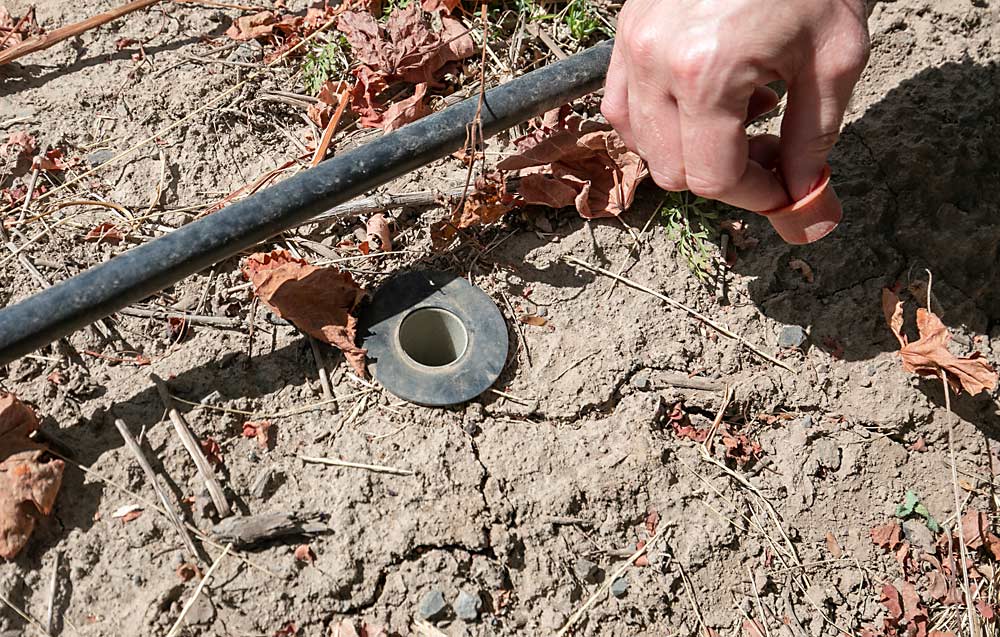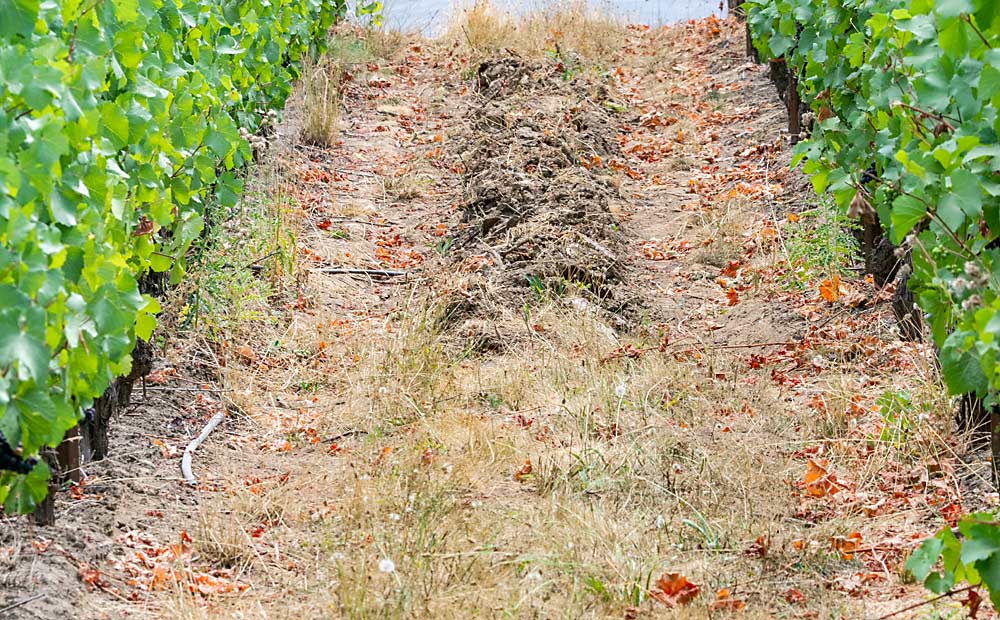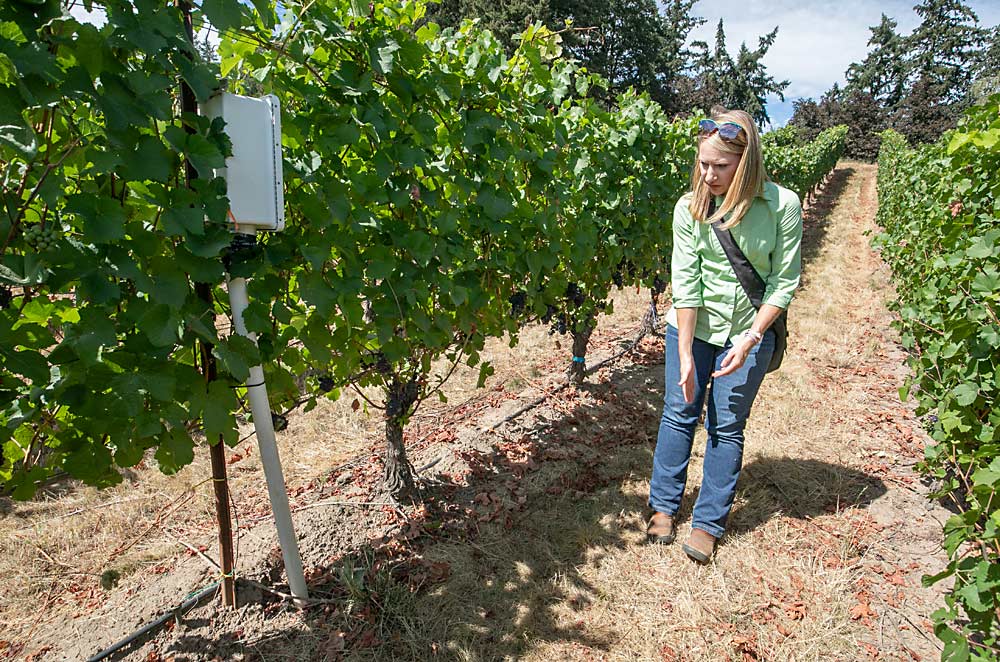
By design, soil moisture sensors tell growers in arid regions when to irrigate. Trying to install them in Oregon’s typically wet Willamette Valley, when it’s common to hit groundwater at 2 or 3 feet, is a whole different ball game.
“I had to bail out water to insert the thing,” said Patty Skinkis, professor and viticulture extension specialist at Oregon State University. “That’s why people don’t want to do these kinds of sensors … but we recognize that there was no basic information about what our soils are doing in the summer because we don’t irrigate.”
Skinkis installed the sensors so growers there don’t have to, designing a baseline study of soil moisture dynamics in three soil types. It proved fortuitous that she installed those sensors in January 2020, so they were poised to collect data during the hot, dry season in 2021 and a long 2022 season with a cold wet spring followed by summer heat.
“The real fortunate thing of the three seasons we collected the data was we encompassed variable rainfall patterns,” she said. And during the 2021 drought, the data helped to reassure growers that most vines had enough moisture in the “soil’s reservoir” to make it through.
Understanding soil water dynamics — given the role water stress plays in fruit quality — will help the Willamette wine industry adapt to a changing climate with drier growing seasons, she said.
Small site, big implications
Skinkis set up her trial at Allison Vineyard in Newberg. The small, sloping site includes three soil types, all planted in 2008 with Pinot Noir on 101-14 rootstock. Vineyard manager Chad Vargas of NewGen Vineyard Services suggested the site to Skinkis when she proposed the soil moisture study to the Oregon Wine Board’s research commission, which is funding the work.
Vargas said he suggested the site, located at the Allison Inn and Spa, because it was planted to be an experiment, designed with soil type — sedimentary, volcanic and silt deposit — in mind.
“When we got the site mapped before we planted it in 2008, we discovered that it had all three types in pretty distinct places, so we were able to plant it in three blocks,” reflecting the soil types, he said.
“We’ve always known that in the volcanic soil, the canopy is not as lush,” he said. “And if we see mildew, we see it in the (silt deposit), where it is more moist and humid, and the canopy is more vigorous.”
Skinkis installed a variety of soil moisture and electrical conductivity sensors, learning through trial and error what could survive the Willamette’s wet springs. She coupled that with weather data and vine growth response measurements.

Walking the site, the difference in vine size was distinctive between the volcanic, reddish and well-drained Saum soil and the glacial-deposit Woodburn-Willamette soil on the lower slope, where the vines were greener and more vigorous about a month before harvest in early September.
Soil moisture data also showed that underneath those vigorous vines, the top layer of soil dried out more quickly through the season. However, the vines showed the least amount of water stress because the deeper soil promotes deeper root growth.
“It’s deeper and it holds more water because of where it’s positioned,” she said.
Typically, Willamette Valley growers respond to water stress by tilling under their cover crops to reduce competition. But with increasing interest in the no-till practices promoted by the regenerative agriculture movement, Skinkis also aimed to see how much tilling impacted soil moisture levels.
In 2021, most growers tilled. At Allison Vineyard, Skinkis said her data from tilling small sections showed little impact on under-vine soil moisture, replicating the finding from previous tilling trials.
Those deeper-rooted vines illustrate why tilling may not be as effective during drought as many growers expect. Vine roots and cover crop roots may not be competing in the same zone of soil, except in the shallowest soils.
“Probably due to the depth and the timing and where the grapevine roots are, it’s not really having an impact,” she said.
The till or not-to-till question extends beyond strictly soil moisture, though. Tilling produces bare ground, which can lead to dust and spider mite outbreaks. Tilling cover crops also puts more nitrogen in the soil — likely why some vineyards that have tilled for years have struggled after switching to a no-till approach.
“It’s definitely a nitrogen story,” she said, in vineyards that follow the standard practice of a clean under-vine space, either with herbicide or cultivation.

Soil type specifics
Vargas said he’s more interested in the soil sensor data Skinkis collected, which shows when and where in the soil profile the vine roots are drawing down each soil type’s water reserve, from wet spring through often-dry summer and fall.
“We know fruit quality is tied to soil moisture, especially water stress late in the season,” he said. “If you are in a (silt deposit) soil, it’s not really entering that stress until after harvest, while a (volcanic) Jory soil is well-drained, and you get a moderate dry down.”
At Allison, they recorded the highest water stress in the sedimentary soil, the Dupee soil. Digging a soil pit showed why: The roots were only in the top 2 feet of soil before they hit a heavy clay layer.
“It’s a function of the soil type restricting rooting,” Skinkis said. Sensors she set below 18 inches accumulated water, but there were no roots to take advantage of it.

“That’s the trick, having the sensors where the roots are,” she said.
In the Saum and Woodburn-Willamette soils, she found fine roots at much deeper profiles.
Understanding these relationships between soil type and water-holding capacity will help growers decide if tilling a cover crop could reduce water stress and help to plan future plantings, she said.
“Many of the vineyards that were planted years ago were set up when we were in a different pattern of rainfall,” Vargas said. And in the northern Willamette Valley, where groundwater use for agriculture is often restricted, “we’re not going to get irrigation water to support high-end viticulture.”
For that reason, growers need to begin rethinking their rootstock choices, Skinkis said. She recently rebooted research on a rootstock trial planted 25 years ago at OSU’s Woodhall research vineyard near Monroe in the southern Willamette Valley.
Over the past three years of data collection, she found that “the drought-tolerant rootstocks are more drought tolerant and have larger canopies than the ones that are devigorating,” she said. That may seem obvious, but it’s the first step in understanding how rootstocks tested in California will perform with Pinot Noir in Willamette conditions, and it can help inform growers’ options beyond the region’s traditional selections of Riparia Gloire, 101-14 and 3309C. “It’s about making the right choice for the soil and site characteristics, because not every site is going to have a deep soil profile.”
Riparia Gloire, once preferred for controlling vigor in the region, is now falling out of favor because it struggles with dry conditions, Vargas said.
“We’re going to start really understanding these soil dry-down curves and how to match our rootstocks up to that,” he said. “We’re entering an era where we need rootstocks for deeper water extraction.”
—by Kate Prengaman






Leave A Comment